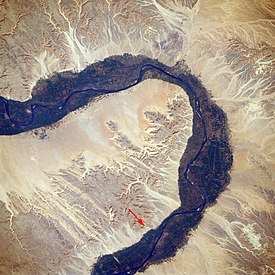Valley of the Kings
necropolis in ancient Egypt
The Valley of the Kings (Arabic: وادي الملوك Wādī al Mulūk) is a valley in Egypt. From the 16th to 11th centuries BC, tombs were built there for the Pharaohs and powerful nobles.[1][2]

The valley is on the west bank of the Nile across from Luxor.[3] Some of the people buried there are:
The valley is one of the most famous archaeological sites in the world. In 1979 it became a World Heritage Site, with the rest of the Theban Necropolis.[4] Exploration, excavation and conservation continues in the valley, and a new tourist centre has recently been opened.

Geology and climate change
There is little year-round rain in this part of Egypt, but there are rare flash floods that hit the valley. These tons of debris into the open tombs.[5]
References change
- ↑ Maspero, Gaston (1913). Manual of Egyptian Archaeology, Sixth English Edition. H. Grevel and Co. p. 182. ISBN 1-4219-4169-4.
- ↑ "Theban Mapping Project". Theban Mapping Project. Retrieved 2006-12-04.
- ↑ Siliotti, Alberto (1997). Guide to the Valley of the Kings. Barnes and Noble. p. 13. ISBN 88-8095-496-2.
- ↑ "Ancient Thebes and its necropolis". UNESCO Work Heritage Sites. Retrieved 2006-12-04.
- ↑ Sampsell, Bonnie M. 2003. A traveler's guide to the geology of Egypt. Cairo: American University Press, p78. ISBN 977-424-785-X
Further reading change
- Siliotti, Alberto (1997). Guide to the Valley of the Kings. Barnes and Noble. ISBN 88-8095-496-2. – A good introduction to the valley and surroundings